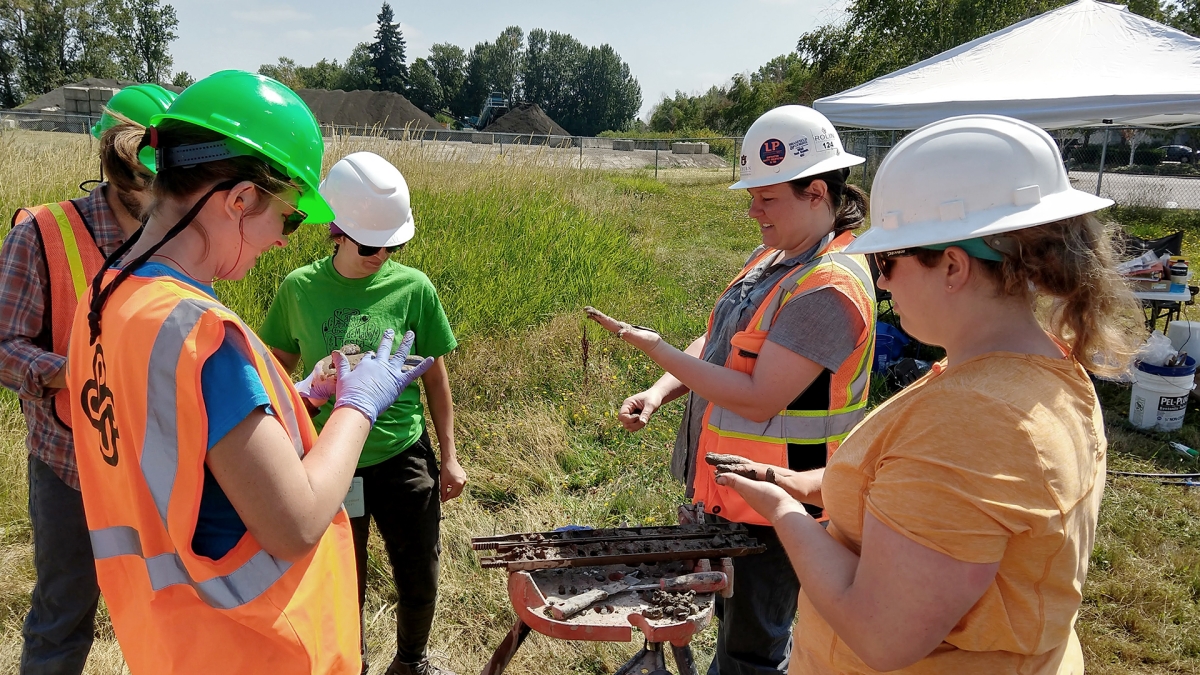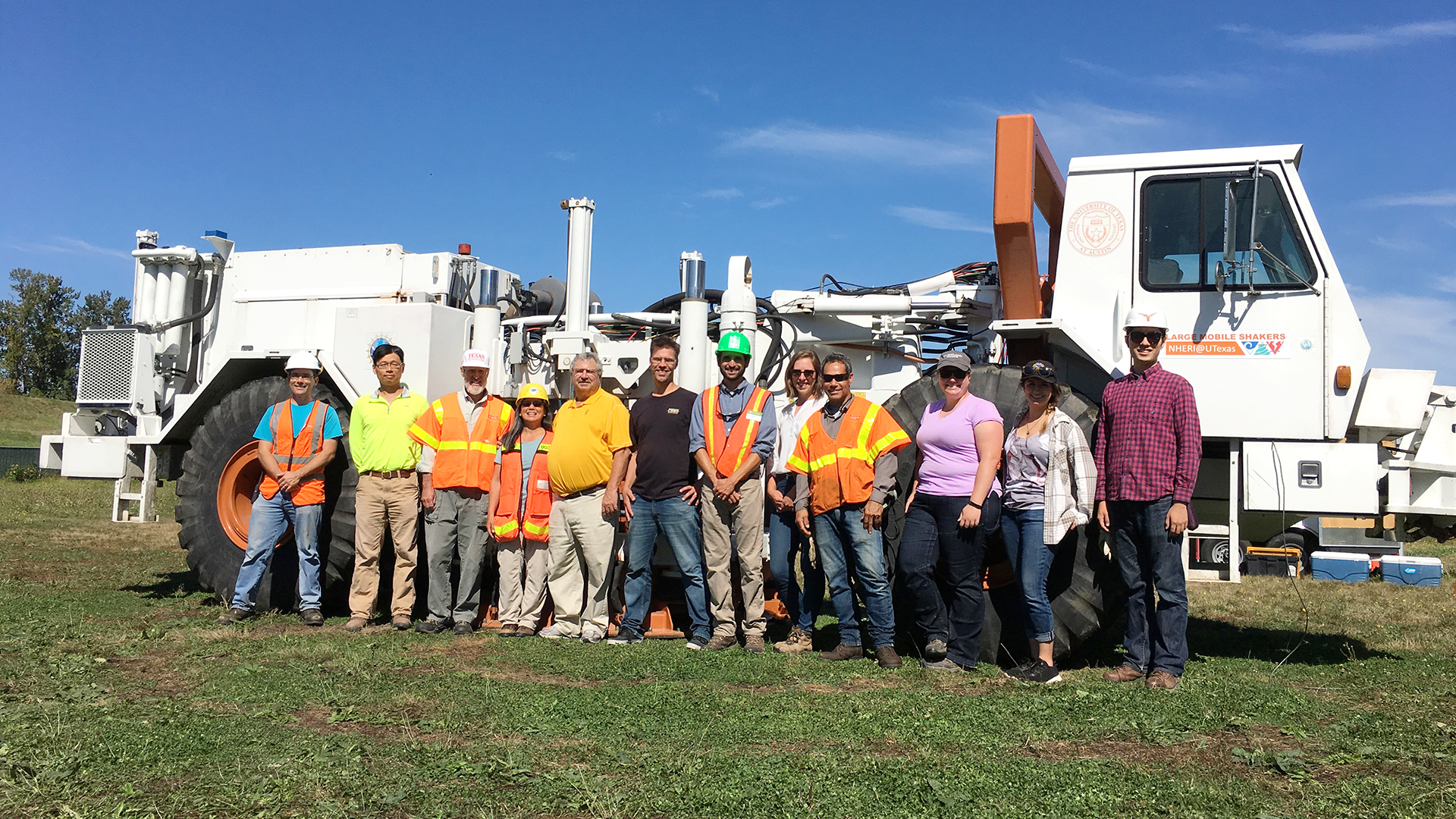Sustaining solid ground

Recent ASU civil engineering doctoral graduate Elizabeth Stallings Young (second from the right) is shown with Portland State University students and staff members involved in characterizing soils near the Portland International Airport, one of two main sites for a major soil liquefaction research project supported by the National Science Foundation. Photo by Leon van Paassen/ASU
A team of faculty members and students in the Ira A. Fulton Schools of Engineering at Arizona State University contributed to a major geotechnical engineering field research project recently recognized with a 2021 Western States Seismic Policy Council Award in Excellence.
Associate Professor Leon van Paassen led the group from ASU’s Center for Bio-mediated and Bio-inspired Geotechnics, in a collaboration with researchers from Portland State University and the University of Texas at Austin. The endeavor has been funded by the Natural Hazard Engineering Research Infrastructure program of the National Science Foundation.
Van Paassen and Professor Edward Kavazanjian, director of the Center for Bio-mediated and Bio-inspired Geotechnics, have collaborated on projects to reduce the impact of earthquakes on soils. One of these aftereffects is liquefication, or the process by which soil saturated with water loses strength, which can lead to ground failure.
The multi-university project involves microbially induced desaturation — called the MID technique — for mitigation of earthquake-induced liquefaction in silty soils.
Seeking earthquake and engineering solutions
The work has included treating two test sections located within the Port of Portland Critical Energy Infrastructure hub (the Harborton site) and adjacent to Portland International Airport (the Sunderland site).
The map shows two sites in the vicinity of Portland International Airport and the Port of Portland Critical Energy Infrastructure hub that are test sections for the research to develop techniques for reducing soil damage as a result of earthquakes. Map courtesy of Portland State University
There, researchers monitored the treatment performance and the level of desaturation through a variety of methods and shook the ground at one test section using the NHERI@UTexas T-Rex mobile shaker system.
“The MID technique is particularly noteworthy because it can be used to address two problems that have vexed earthquake engineers for decades,” said Kavazanjian, who is a Regents Professor at ASU and the Ira A. Fulton Professor of Geotechnical Engineering.
“Due to its nondisruptive nature, it can be used to remediate existing infrastructure at risk from liquefaction. And the success in achieving desaturation at the two test sites indicates the potential for remediating the silty soils common to the Portland area that are not amenable to conventional liquefaction mitigation techniques,” he said.
The Center for Bio-mediated and Bio-inspired Geotechnics team provided technical and logistical support to the Portland State University team that led the overall project. The center's support also included advising on the layout of the installation for the two test sections, developing the treatment solution and treatment regimen, installing downhole sensors for soil moisture content and salinity, and data interpretation.
The project also included a half-day workshop in Portland at which more than 50 engineers and government agency officials were introduced to the MID technique and briefed by ASU, PSU and UTexas team members on work at the two test sections.
Student and industry contributions
Fulton Schools alumni Elizabeth Stallings Young and Caitlyn Hall have been integral members of the project team. Earlier this year, Stallings Young earned a doctoral degree in civil engineering and Hall earned a doctoral degree in environmental engineering.
Center for Bio-mediated and Bio-inspired Geotechnics industrial partners Geosyntec Consultants and Conetec also provided support services for the project.
Preliminary results will be reported in a paper to be presented at the next American Society of Civil Engineers Lifelines Conference, which will commemorate the 50th anniversary of the historic 1971 Sylmar (San Fernando) earthquake in Southern California.
Monitoring and data analysis continues while the project team seeks supplemental support from the NSF for additional work at the site near the Portland International Airport. Read more about the project and the award on Page 6 of the Summer 2021 WSSPC newsletter.
Plans for deeper geotechnic probing
Van Paassen says the Portland project first emerged from CBBG’s successful 2018 pilot project in Toronto, where microbial processes were used to stabilize soils by inducing carbonate mineral precipitation. That effort was funded in part by support from NSF Rapid Response Research, or RAPID, grant for work being done by a CBBG industry partner Groundwater Technologies Inc. on rehabilitation of the Toronto waterfront.
The RAPID program was established by the NSF Engineering Directorate to take advantage of unique opportunities for research with a short time horizon. In the Toronto project, the RAPID grant was used to mobilize the big T-Rex shaker and its associated mobile soil laboratory, Kavazanjian says.
In the Portland project, the RAPID grant work took advantage of the availability of the T-Rex shaker in the Pacific Northwest.
Members of the Field Demo 2 team for a major geotechnical engineering project supported by the Natural Hazard Engineering Research Infrastructure program pose with the large T-Rex mobile ground shaker system used in the team’s work. Fulton Schools Professor Edward Kavazanjian from the Ira A. Fulton Schools of Engineering at Arizona State University is fifth from the left; Fulton Schools Associate Professor Leon van Paassen is next to Kavazanjian in black. Photo by Arash Khosravifar/Portland State University
When Arash Khosravifar and Diane Moug, PSU assistant professors of civil and environmental engineering, became aware of the availability of T-Rex, they contacted Kavazanjian and then joined with van Paassen and other colleagues Kenneth Stokoe, a professor at the University of Texas and the principal investigator for the T-Rex project, and Yumei Wang, a former geohazards engineer for the Oregon Department of Geology and Mineral Industries and the current senior adviser on infrastructure resilience and risk with PSU.
ASU Associate Professor Leon van Paassen takes samples of extracted water at the site of the project to test microbially induced desaturation for mitigating earthquake induced liquefaction in soils. Photo by Arash Khosravifar/Portland State University
The group prepared a second RAPID project proposal focusing on microbially induced desaturation by bacteria, which is used to produce nitrogen gas for mitigation of liquefaction in the silty soil characteristic of the Portland area.
Preparations for the project began in spring 2019, including plans to use the T-Rex shaker again to evaluate whether the MID could work for mitigating earthquake induced liquefaction. The soil treatment was done later that year, followed by shaking of the ground with T-Rex and monitoring using the mobile soils laboratory equipment. Monitoring with sensors installed at the site has been ongoing since then.
“We plan for this to continue for the next several years because one of the big challenges is to demonstrate that the entrapped gas is persistent,” van Paassen said.
The team also hopes to return to the site with T-Rex after some modifications are made to the equipment, he said, because “it turned out that the shaking by the T-Rex was not strong enough to evaluate the performance of MID in the deeper soils.”
A current proposal to the NSF requests support to shake the site once again with T-Rex after making modifications to the equipment, demonstrating the ability of the desaturation technique to mitigate liquefaction and then continue monitoring for another five years “to find out how the entrapped gas is distributed in the soil, develop models to predict how the gas is distributed and how the soil responds,” van Paassen said.
More Science and technology

ASU-led space telescope is ready to fly
The Star Planet Activity Research CubeSat, or SPARCS, a small space telescope that will monitor the flares and sunspot activity…

ASU at the heart of the state's revitalized microelectronics industry
A stronger local economy, more reliable technology, and a future where our computers and devices do the impossible: that’s the…

Breakthrough copper alloy achieves unprecedented high-temperature performance
A team of researchers from Arizona State University, the U.S. Army Research Laboratory, Lehigh University and Louisiana State…




